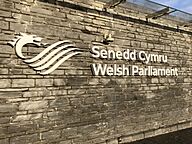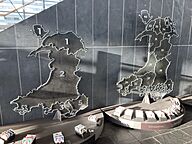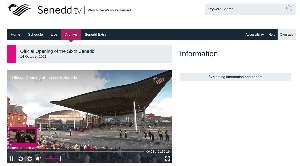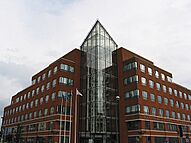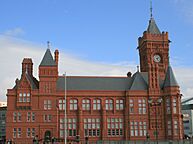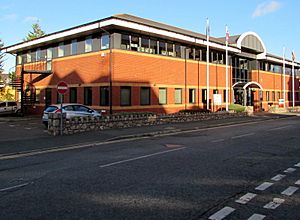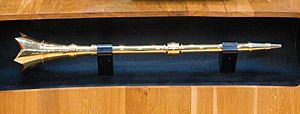Senedd facts for kids
Quick facts for kids Senedd CymruWelsh Parliament |
|
|---|---|
| Sixth Senedd | |
 |
|
| Type | |
| Type | |
| History | |
| Founded | 12 May 1999 |
| Preceded by | Welsh Office (1965–1999) |
| Leadership | |
|
Llywydd
(Presiding Officer) |
Elin Jones, Plaid Cymru
Since 11 May 2016 |
|
Deputy Presiding Officer
(Dirprwy Lywydd) |
David Rees, Labour
Since 12 May 2021 |
|
Trefnydd (Leader)
|
Jane Hutt, Labour
Since 21 March 2024 |
|
Vaughan Gething, Labour
Since 20 March 2024 |
|
|
Leader of the Opposition
|
Andrew RT Davies, Conservative
Since 24 January 2021 |
|
Chief Executive and Clerk
|
Manon Antoniazzi
Since April 2017 |
| Structure | |
| Seats | 60 |
 |
|
|
Political groups
|
Government (30)
Opposition (30)
|
| Elections | |
| Additional-member system (until 2026) Party-list proportional representation (closed list) (from 2026) |
|
|
Last election
|
6 May 2021 |
|
Next election
|
On or before 7 May 2026 |
| Meeting place | |
 |
|
| Siambr (debating chamber) in the Senedd building, Cardiff, Wales | |
 |
|
The Senedd (pronounced SEN-edh) is also known as the Welsh Parliament. It is the main law-making body for Wales. This elected group makes laws for Wales, agrees on certain taxes, and checks the work of the Welsh Government. Both Welsh and English are used in its official business.
From May 1999 until May 2020, the Senedd was called the National Assembly for Wales. People often simply called it the Welsh Assembly.
The Senedd has 60 members. They are known as Members of the Senedd (MS), or AS in Welsh. Since 2011, members are elected for five years. They use a special voting system called the additional member system. In this system, 40 MSs represent smaller areas called "constituencies". They are elected by first-past-the-post voting, where the person with the most votes wins. The other 20 MSs represent five "electoral regions" and are chosen using a system that aims for fair representation. Usually, the party with the most members in the Senedd forms the Welsh Government.
Contents
History of the Welsh Parliament
How Wales Gained its Own Parliament
Before the Senedd, there was a group called the Council for Wales and Monmouthshire. It was set up in 1949 to tell the government how its actions affected people in Wales. In 1964, the Welsh Office was created, which helped set up a way to govern Wales.
In 1969, a special group called the Kilbrandon Commission looked into giving more power to Scotland and Wales. Their ideas led to a plan in 1974 for a Welsh Assembly. However, people in Wales voted against this idea in a referendum in 1979.
After the 1997 election, the new government wanted a Welsh Assembly. They felt it would be more accountable than the Welsh Office. In a referendum on 18 September 1997, people in Wales voted to create the National Assembly for Wales. Just over 50% of voters said yes.
The next year, the Government of Wales Act 1998 was passed. This law created the Assembly. On 1 July 1999, the Welsh Office closed, and its powers moved to the new Assembly.
Getting More Powers for Wales
In 2002, the Welsh Government asked an independent group, the Richard Commission, to review the Assembly's powers. This group suggested that the Assembly should be able to make its own laws in some areas.
The Government of Wales Act 2006 gave the Assembly more power. It could now pass its own laws, called "Assembly Measures". However, it still needed approval from the UK Parliament for new powers. This Act also separated the Welsh Government from the Assembly, making it more like a parliament.
After another referendum on 3 March 2011, the Welsh Assembly gained even more direct law-making powers. This meant it no longer needed to ask the UK Parliament for permission to pass laws in 20 areas. These powers were further increased by the Wales Act 2014 and Wales Act 2017. The 2017 Act changed how powers were shared. Now, the UK government has specific "reserved" powers, and the Senedd controls everything else.
Some of the areas the Senedd can make laws about include health, education, transport, the environment, farming, and local government.
Why the Name Changed to Senedd
In July 2016, members of the Assembly agreed that its name should show it was a national parliament. They asked the public what they thought. Most people agreed the name should change.
In 2019, a new law was proposed to change the name. This law, the Senedd and Elections (Wales) Act 2020, was passed. It changed the name of the Assembly to "Senedd Cymru" or the "Welsh Parliament". The new name officially came into effect on 6 May 2020. Members are now called Members of the Senedd (MS).
How the Senedd's Powers are Limited
When the UK left the European Union, a new law was passed called the United Kingdom Internal Market Act 2020. This law aims to stop trade barriers within the UK. It also limits how much the Senedd can use its law-making powers in economic areas.
This means that if the Senedd wants to introduce new or stricter rules for businesses, these rules might only apply to goods made in Wales. This could make Welsh businesses less competitive. It limits the Senedd's ability to make different economic choices from the UK government.
Plans for More Members
In November 2021, the Welsh Labour and Plaid Cymru parties agreed to work together. One of their plans is to increase the number of Senedd members from 60 to between 80 and 100.
In March 2022, both parties supported this idea. They believe more members are needed for the Senedd to do its job properly. In May 2022, plans were announced to increase the number of MSs to 96. They also plan to change the voting system. On 8 June 2022, the Senedd voted in favour of expanding the number of MSs.
Buildings of the Welsh Parliament

The Senedd Building in Cardiff Bay
The main building for the Senedd is in Cardiff Bay. It is called the Senedd. The building was designed to be open and clear. It uses traditional Welsh materials like slate and Welsh oak.
The Senedd building holds the main debating room, called the Siambr, and other committee rooms. Queen Elizabeth II officially opened it on St David's Day, 1 March 2006.
The building is designed to be good for the environment. It uses an Earth Heat Exchange system for heating. Rainwater is collected from the roof to flush toilets and clean windows. The roof also has a special wind cowl that brings natural light and air into the debating chamber.
Watching the Senedd on TV
The Senedd's own website, Senedd.tv, shows about 35 hours of content each week. You can watch it in both English and Welsh. Important events, like questions to the First Minister, are shown live. They are also recorded on BBC Parliament.
Other Important Buildings
The debating chamber was first in a building called Tŷ Hywel. This building is next to the Senedd building and is connected by a walkway. Members of the Senedd still have their offices in Tŷ Hywel.
The Senedd Commission also looks after the Pierhead Building. This building has an exhibition about the Senedd. It is also the Visitor and Education Centre and has a small gift shop.
North Wales Office
The Senedd also has an office in Colwyn Bay in North Wales. This office is open to the public. People can visit to get information about the Senedd.
Who Works at the Senedd?
Elected Officials
After each election, the Senedd chooses one of its members to be the Llywydd (Presiding Officer). They also choose a Deputy Presiding Officer. The Llywydd is like the speaker of the parliament. Elin Jones has been the Llywydd since 2016. The Llywydd also leads the Senedd Commission. Usually, the Llywydd and Deputy Presiding Officer do not vote in most decisions.
Permanent Staff
The Senedd also has permanent staff who help it run smoothly. They are employed by the Senedd Commission. They are not government civil servants, but they have similar working conditions.
What Powers Does the Senedd Have?
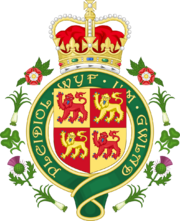
The Senedd has 60 elected members. They are called Members of the Senedd (MS). The Welsh Government is the executive part of the Senedd. It has been led by the Labour party since 1999. The current First Minister is Vaughan Gething, who started in March 2024.
The Senedd can pass laws, called Acts of Senedd Cymru. It can make laws in all areas that are not specifically kept for the UK Parliament. These "reserved matters" are listed in a special part of the Government of Wales Act 2006.
This means the Senedd has powers over things like:
- Farming, fishing, and forests
- Welsh culture
- Developing the economy
- Education and training
- The environment
- Health and health services
- Roads and transport
- Local government
- Tourism
- The Welsh language
Things that are "reserved" for the UK Parliament include:
- Foreign affairs (dealing with other countries)
- Police and justice
- Money (currency)
- Most benefits
- Most taxes
- Defence (the military)
Before 2015, the Senedd could not change taxes. However, it could affect local taxes and charges for government services. For example, Wales abolished charges for NHS prescriptions. University tuition fees are also different for Welsh students studying in Wales.
The Senedd gained direct law-making powers after a referendum on 4 March 2011. On 3 July 2012, the Welsh Assembly passed its first Act, the Local Government Byelaws (Wales) Act.
The Wales Act 2014 and Wales Act 2017 gave the Senedd power over these taxes:
- Non-Domestic Rates in Wales (from 2015)
- Land Transaction Tax (from 2018)
- Landfill Disposals Tax (from 2018)
- Welsh Rates of Income Tax (from 2019)
Members and How They Are Elected
The Senedd has 60 members. Forty of these members are elected from single areas called constituencies. They are chosen using a "first past the post" system, where the person with the most votes wins. These constituencies are the same as those used for the UK Parliament.
The other twenty members are elected from five larger regions: Mid and West Wales, North Wales, South Wales Central, South Wales East and South Wales West. Each region elects four members. This system helps make sure that the number of seats a party gets is fairer compared to the votes they receive.
In April 2020, the Senedd became the first parliament in the UK to meet online. Because of the COVID-19 pandemic, they held important meetings using video calls. These sessions were then shown on Senedd.tv.
Senedd Elections
|
||||||||
There have been six elections for the Senedd: in 1999, 2003, 2007, 2011, 2016, and 2021. Elections now happen every five years.
The next Senedd election is planned for Thursday 7 May 2026.
Election Results Summary
| Assembly/ Senedd |
Year | Turnout | Seats | Governments | |||||
|---|---|---|---|---|---|---|---|---|---|
| Labour | Plaid Cymru |
Conservative | Lib Dems |
UKIP | Others | ||||
| 1997 | 50% | Devolution referendum | |||||||
| 1st | 1999 | 46% | 28 | 17 | 9 | 6 | – | – | Michael (Labour minority) Interim Morgan (Labour minority) Morgan I (Labour – LD) |
| 2nd | 2003 | 38% | 30 | 12 | 11 | 6 | 0 | 1 (JMIP) | Morgan II (Labour majority until 2005), minority after 2005 |
| 3rd | 2007 | 44% | 26 | 15 | 12 | 6 | 0 | 1 (BGPVG) | Morgan III (Labour minority) Morgan IV (Labour – Plaid) Jones I (Labour – Plaid) |
| 2011 | 36% | Devolution referendum | |||||||
| 4th | 2011 | 42% | 30 | 11 | 14 | 5 | 0 | – | Jones II (Labour minority) |
| 5th | 2016 | 45% | 29 | 12 | 11 | 1 | 7 | – | Jones III (Labour–LD minority, Lib Dem coalition) Drakeford I (Labour–LD–IND majority) |
| 6th | 2021 | 47% | 30 | 13 | 16 | 1 | 0 | – | Drakeford II (Labour minority)
Gething (Labour minority) |
Current Members of the Senedd
See also
 In Spanish: Parlamento Galés para niños
In Spanish: Parlamento Galés para niños


